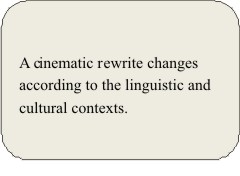Cinematic Rewrite—An Example
Cinematic rewriting or remakes is a very common aspect of the Indian film industry. A rec ent example is ent example is
that of Bhool Bhulaiya in Hindi which was a remake of the Tamil Chandramukhi which in turn was remade from the Malayalam Manichitrathazhu. An interesting aspect of these movies is that all of them were huge box office hits in the languages they were made. However, they vary in terms of the cultural connotations of each region. There are cosmetic as well as intrinsic changes in the narrative as you pass from one language to the other. The traditional house with a joint family set-up which is the backdrop of the film, is not difficult to depict even in this day in any part of India. But difficulties crop up in the depiction of familial relationships. In the Malayalam original, the ‘rival’ to the heroine is her husband’s cousin or uncle’s daughter. According to the matrilineal system peculiar to Kerala alone, one can marry your maternal uncle’s son/daughter. This could not be replicated in Tamil or the other language versions, as this is a forbidden relationship according to those customs. So this character becomes the granddaughter of the gardener in the Tamil version. The (ghost)woman who is a Tamilian in Malayalam, becomes a Telugu in Tamil and a Bengali in Hindi. This is quite in keeping with the demands of the story, where the (ghost)woman is a beautiful dancer from another state, speaking a different language.
Besides such cosmetic changes, there are differences in characterization and narrative style also. The characters in Malayalam are subtle and understated, keeping with the Malayali taste for sober realism. The major such change is in the central character of the psychiatrist. He is slightly eccentric in Malayalam but becomes almost a superman in Tamil, bashing up his rivals and dazzling the others with his mental powers. One of the reasons for this transformation could be that this role was played by superstar Rajnikanth who is expected to perform such miraculous deeds on screen. However, the major reason is the regional/cultural taste for larger than life characters. Differences of this sort can be seen across the various languages that the film was made and can be attributed to differences in cultural tastes of various regions. Since cinema is heavily dependent upon viewer satisfaction, such differences would obviously influence the reception of a popular art form like cinema. Naturally we can expect these differences in cinematic rewrites.
|